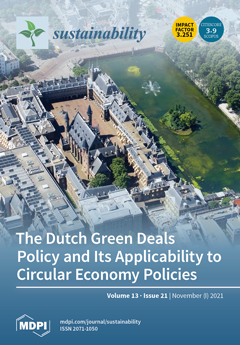Rice farming in coastal areas is often victim to flooding as a result of climate change. Low-cost adaptation strategies are required to increase resilience and rice productivity in these flood-prone coastal areas. In this study, enriched Azolla extract (EAE) liquid biofertilizers, combined with
[...] Read more.
Rice farming in coastal areas is often victim to flooding as a result of climate change. Low-cost adaptation strategies are required to increase resilience and rice productivity in these flood-prone coastal areas. In this study, enriched Azolla extract (EAE) liquid biofertilizers, combined with selected stress-tolerant rice varieties, were tested in farmers’ fields in Pangandaran, West Java from June to October 2020. This study aimed to investigate the effectiveness of EAE in increasing the yield of different rice varieties. The research was arranged as a split-plot design with five replications. The main plot was the EAE application (T1 = 3 ton ha
−1 compost and T2 = 3 ton ha
−1 compost + 10 L ha
−1 of EAE), and the sub-plots were stress-tolerant rice varieties (V1 = Inpari 43, V2 = Mawar, V3 = Inpari 30, V4 = Inpara 03, V5 = Mendawak). The application of EAE of 10 L ha
−1 significantly affected the rice grain yield, which was 37.06% higher than that of the control plot. The average grain yield of the five varieties under EAE treatment (5.51 ton ha
−1) was greater than the grain yield of local farmers’ fields (3.78−4.97 ton ha
−1). Inpari 43 had the highest grain yield with 5.90 ton ha
−1, but the yield was not significantly different from the Mendawak variety (4.90 ton ha
−1). This result suggests that EAE and selected stress-tolerant rice varieties (Inpari 43 or Mendawak) are an effective adaptation strategy to increase rice farms’ resilience and productivity in coastal areas prone to flooding.
Full article





